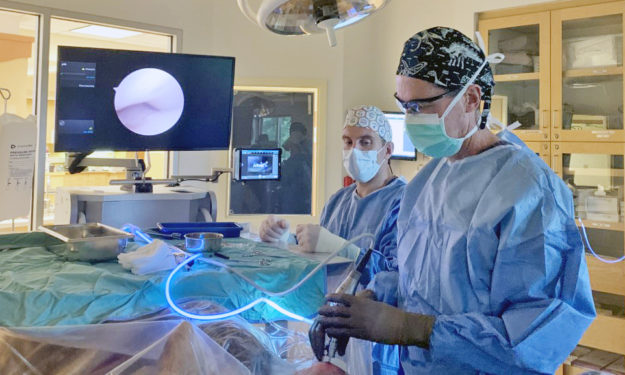Minimally Invasive Surgery (MIS) – Getting Started

As the human-animal bond continues to deepen, pet owners are increasingly concerned about reducing post-surgical pain for their pets. Pet owners also associate their own medical experiences with those of their pets and frequently ask for less invasive, less painful procedures. Minimally invasive surgery, (MIS), and minimally invasive procedures in general, have grown as a viable option for surgery in pets in veterinary medicine over the last 10 – 15 years.
One of the many benefits of taking a minimally invasive approach over a more traditional surgical route is the recovery time. In most cases, the smaller surgical incision and lesser impact to surrounding tissue from a minimally invasive approach, means there is a shorter recovery time. The incision is significantly smaller, as a result it heals faster, and most pets do not require an overnight stay at the hospital. They will be sent home in an e-collar, but the shorter time to heal means you won’t need to use the cone for as long as you might with a longer or deeper incision.
Incorporating tools such as video scoping, diagnostic imaging and interventional radiology gives our medical team and your pet non-surgical minimal invasive options as well.
To understand your options for veterinary minimally invasive procedures and surgery, we have compiled the following resources:
| Minimally Invasive Surgery |
| What is Minimally Invasive Surgery? |
| Endoscopy Procedures Explained |
| Arthroscopic Surgeries Explained |
| What is Interventional Radiology? |
Benefits of Minimally Invasive Surgery and Non-surgical Procedures
- Smaller incision(s) or no incision
- Faster recovery
- Less time in the hospital
- Less scarring
- Less post-surgical discomfort
Types of procedures that can be minimally invasive:
Ethos Veterinary Health hospitals offer a variety of minimally invasive procedures and surgical options for your pet. This is an incomplete list, for more information and a consult, please contact your Ethos hospital surgery department.
- Orthopedic Surgeries
- General Surgeries
- Mass Removals, Biopsy
- Thoracic Surgeries
- Neurologic Surgeries
- Oncologic Surgeries
- Foreign body removal
- Stent Placement at Ethos hospitals with fluoroscopy
- There are numerous indications for upper GI endoscopy including vomiting, regurgitation, diarrhea, lack of appetite, weight loss, evaluation of masses (tumors) and ulcers.
- Upper GI endoscopy can also be used therapeutically for removal of GI foreign bodies, dilation of esophageal strictures and removal of polyps in the stomach.
Find an Ethos hospital near you